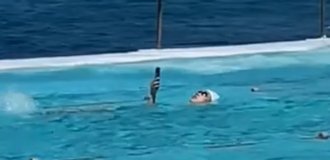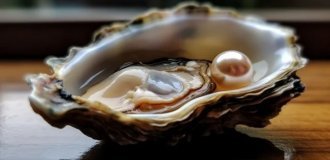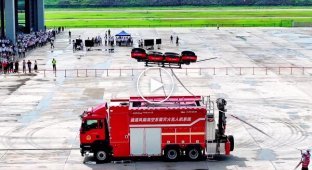A Blank Fire from the "Catapult." The Battle of the Former Allies at Mers-el-Kebir (6 photos)
A blank shot from the "Catapult." The battle of the former allies at Mers-el-Kebir
After France's surrender and Italy's entry into World War II on Germany's side, the "Mistress of the Seas" found itself in a difficult position. By mid-1940, England was left virtually alone against the entire German war machine. The threat of an invasion of the islands was very real. The British faced a difficult choice. 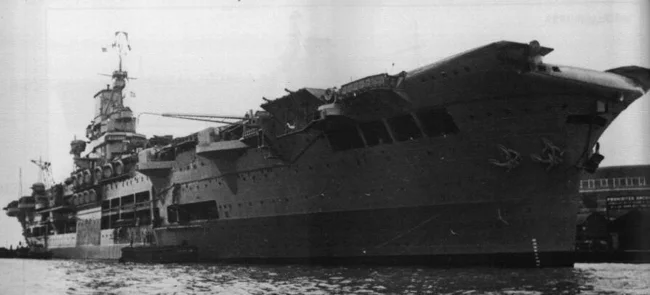
Aircraft carrier Ark Royal, 1940
Background
In this situation, the only restraining factor was the Royal Navy. But even it did not seem so unshakable – in the long run, after France's defeat, the Kriegsmarine was expected to be significantly strengthened. After all, the French fleet, despite the declarations of Commander-in-Chief Jean-Louis Darlan, was subordinate to the Vichy regime.
After the British Admiralty learned of the impending fate of the French fleet, orders were issued to form Force H, which would expand the operational area in the Mediterranean. Escorted by destroyers, the battlecruiser Hood and the aircraft carrier Ark Royal arrived at Gibraltar. Later, the light cruisers Enterprise and Arethusa, the battleships Valiant and Resolution, and the destroyers Forester, Foresight, and Escort joined this force. The Royal Navy intended to do everything possible to prevent the French ships from falling into German hands.
Most officers and admirals were unwilling to resolve this issue by force. For example, the commander of the Mediterranean Fleet, Andrew Cunningham, understood the consequences of using force and expressed certain doubts, which were, however, dispelled by the British government. The only thing that could have saved the French fleet was to end its cooperation with Germany and transfer its ships to US or British ports. The French, of course, refused to give up their "trump card." So the British, true to their principles, launched Operation Catapult.
A Forced Betrayal
On the morning of July 3, the French ships in the ports of Plymouth and Portsmouth were disarmed. During the British capture of the submarine Surcouf, an open clash even occurred. Two British officers and a petty officer were killed, and the submarine's crew disembarked only after negotiations. Against their will, many French sailors joined the crews of Free French ships.
Two days earlier, Admiral James Somerville was ordered to strike the Algerian ports of Oran and Mers-el-Kebir. Force "H" under his command put to sea at dawn on July 3. At Mers-el-Kebir, the French were asked to comply with London's demands. Otherwise, the British ships were prepared to open fire. 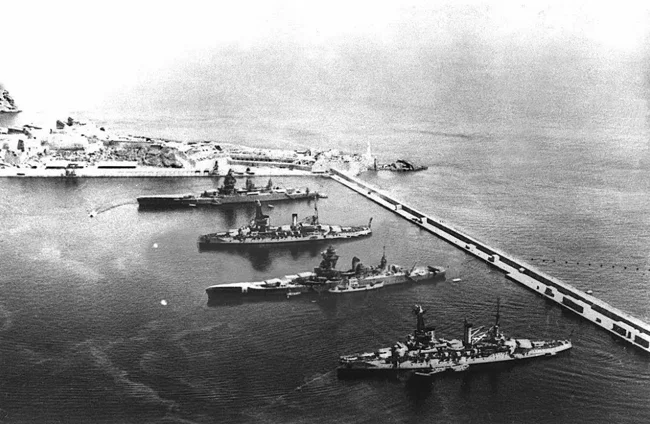
French ships at Mers-el-Kebir
As a preventative measure, British carrier-based aircraft dropped magnetic mines at the entrance to the bay. Negotiations only became more complicated. Ultimately, hopes for a peaceful outcome were dashed. During the eight hours of discussion, the French ships set up steam, crews took up their posts, and coastal batteries were brought to full combat readiness. Admiral Somerville, attempting a peaceful resolution, ordered the ships to move. The ultimatum expired at 18:26, but Operation Catapult had already begun. The former allies opened fire to kill.
The battleship Resolution fired first, and a minute later, the battleship Provence responded. The French ships were unable to move simultaneously due to the confined harbor and were forced to form a column.
The battleship Dunkerque, closest to the British, was hit by a 381 mm British shell, which penetrated the hull, damaged electrical wiring, and punctured fuel tanks.
Provence was also hit by a 381 mm shell. This caused a fire on the deck and the ship began taking on water. After several hits, the dreadnought Bretagne caught fire and was soon engulfed in flames. Two minutes later, it capsized and exploded. A thousand French sailors died instantly. 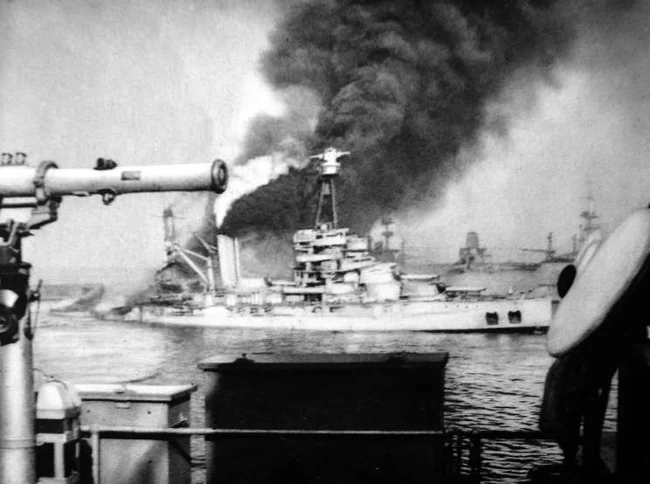
Fire on the Bretagne
At the same time, the destroyer Mogador slowed to allow the transport to pass. A minute later, a 381 mm shell struck its stern, passing through, but detonating all 16 depth charges. The ship lost its stern, miraculously stayed afloat, and reached shore the next day.
Meanwhile, Hood continued to fire at its former ally in the hunt for German raiders. Dunkerque, unable to move, fired. Only the battleship Strasbourg, along with destroyers, managed to break through the British blockade and head for the port of Toulon.
Some time later, the British Admiralty received information about the approaching French ships, and Force H was ordered to retreat.
Attack on Dunkerque
Dunkerque was unable to leave port due to disagreements between its commanders. And since the French press reported that "the damage to the battleship Dunkerque was minor," the British decided to attack it again. This time, they deployed the aircraft carrier Ark Royal and a squadron of Fairey Swordfish torpedo bombers.
The battleship's air defenses, like those of the port, were unprepared to repel such an attack. On July 6, Mers-el-Kébir was attacked by British torpedo bombers escorted by fighters. The first wave of biplanes dropped torpedoes, which missed. The second wave managed to drop three torpedoes, one of which hit the patrol vessel, breaking it in half. Ten minutes later, a third wave arrived, but it was intercepted by French fighters. An aerial battle ensued, resulting in the complete destruction of the biplanes.
The torpedo bombers of the last group dropped two torpedoes. One hit the tug, literally sweeping it from the surface of the water, and the second passed under Dunkerque, striking the previously sunken patrol vessel located on the battleship's starboard side.
This hit detonated 14 100-kilogram depth charges. The powerful shock wave tore a hole 18 by 12 meters in the battleship. Armor plates were torn from the hull, some compartments were flooded, and a slight list developed. Dunkerque took on 20,000 tons of water and sank. It was out of action for many months. Two battleships, several destroyers, and auxiliary ships were seriously damaged. 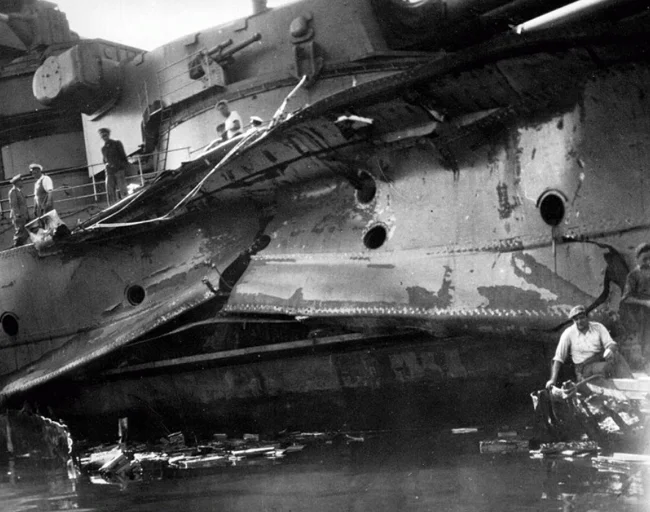
Damaged Dunkerque
1,300 French sailors died as a result of the artillery duel and air attack. However, Force H only partially accomplished its mission: one new battleship, Strasbourg, broke through the blockade, and a second air strike was required to disable the second.
Attack on Dakar
In September 1940, the British Admiralty decided to strike again at the French Navy. Force "M," formed for this mission, was led by Admiral Cunningham. The squadron included the battleships Barham and Resolution, ten destroyers, the cruisers Devonshire, Fiji, and Cumberland, and the aircraft carrier Ark Royal. Free French ships under the command of Charles de Gaulle also headed for Dakar.
Before opening fire, Charles de Gaulle invited the French forces in Dakar to join the anti-Hitler coalition. But despite all his efforts and persuasions, the Dakar authorities refused. On the morning of September 23, three ships entered the foggy harbor. The French were prepared to attack any enemy ship, and the battleship Richelieu fired a warning salvo. 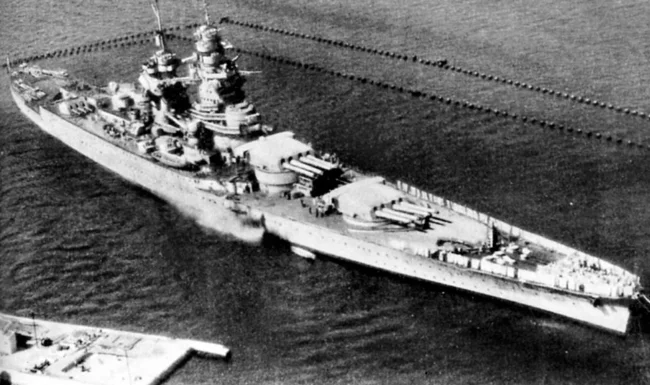
Battleship Richelieu at Mers-el-Kebir
Half an hour later, coastal artillery opened fire. A battle ensued. A single artillery hit disabled the Cumberland and forced it to retreat.
The following day, the French submarine was sunk by British destroyers. Biplanes launched from Ark Royal headed toward the Richelieu. The latter was hit twice by aerial bombs. Simultaneously, the battleships Resolution and Barham began firing. The first salvo damaged the French battleship's second turret, forcing her to open fire with her secondary guns.
The battle continued on September 25, but Richelieu did not surrender. Under cover of a smoke screen, she continued firing at the British battleships. After several hours of artillery dueling, Resolution was hit by a torpedo fired by a submarine. Overall, the battle was unfavorable for the British. Andrew Cunningham decided to retreat.
Results
The attack on French ports in Africa resulted in disproportionate losses for the British. Many of the French Navy's newest ships remained in service, and the destruction of the obsolete dreadnoughts was far from a priority. Thus, it can be said that the Catapult fired a blank.
Besides the direct damage, British radicalism had negative consequences in the political arena. By its actions, Great Britain discredited itself in the eyes of French society. The Vichy regime immediately severed diplomatic relations with Great Britain. The French harbored a grudge for many years. 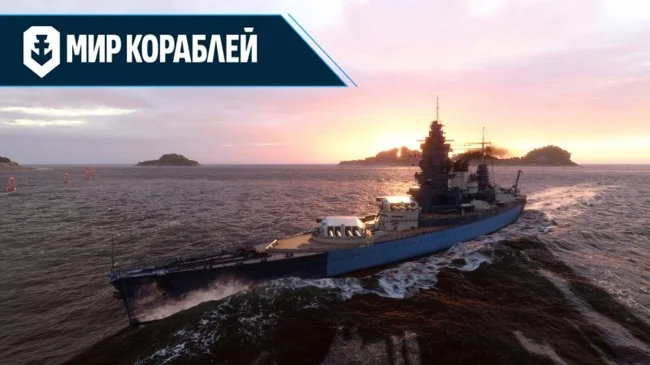
This material was prepared by the volunteer editorial staff of "World of Ships"




